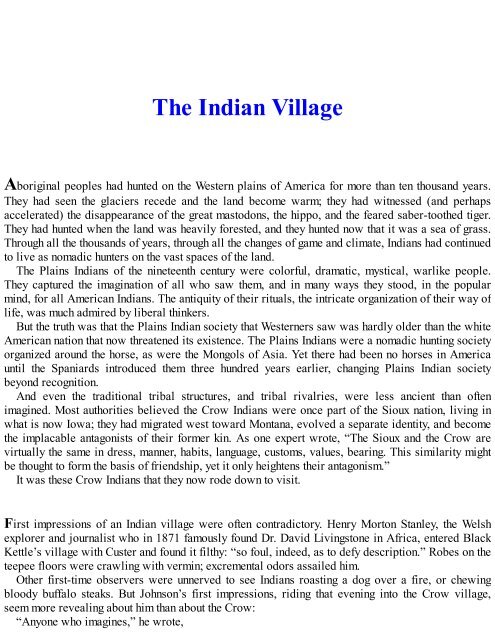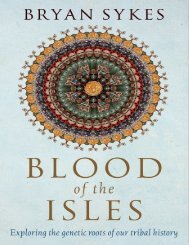Create successful ePaper yourself
Turn your PDF publications into a flip-book with our unique Google optimized e-Paper software.
The Indian Village<br />
Aboriginal peoples had hunted on the Western plains of America for more than ten thousand years.<br />
They had seen the glaciers recede and the land become warm; they had witnessed (and perhaps<br />
accelerated) the disappearance of the great mastodons, the hippo, and the feared saber-toothed tiger.<br />
They had hunted when the land was heavily forested, and they hunted now that it was a sea of grass.<br />
Through all the thousands of years, through all the changes of game and climate, Indians had continued<br />
to live as nomadic hunters on the vast spaces of the land.<br />
The Plains Indians of the nineteenth century were colorful, dramatic, mystical, warlike people.<br />
They captured the imagination of all who saw them, and in many ways they stood, in the popular<br />
mind, for all American Indians. The antiquity of their rituals, the intricate organization of their way of<br />
life, was much admired by liberal thinkers.<br />
But the truth was that the Plains Indian society that Westerners saw was hardly older than the white<br />
American nation that now threatened its existence. The Plains Indians were a nomadic hunting society<br />
organized around the horse, as were the Mongols of Asia. Yet there had been no horses in America<br />
until the Spaniards introduced them three hundred years earlier, changing Plains Indian society<br />
beyond recognition.<br />
And even the traditional tribal structures, and tribal rivalries, were less ancient than often<br />
imagined. Most authorities believed the Crow Indians were once part of the Sioux nation, living in<br />
what is now Iowa; they had migrated west toward Montana, evolved a separate identity, and become<br />
the implacable antagonists of their former kin. As one expert wrote, “The Sioux and the Crow are<br />
virtually the same in dress, manner, habits, language, customs, values, bearing. This similarity might<br />
be thought to form the basis of friendship, yet it only heightens their antagonism.”<br />
It was these Crow Indians that they now rode down to visit.<br />
First impressions of an Indian village were often contradictory. Henry Morton Stanley, the Welsh<br />
explorer and journalist who in 1871 famously found Dr. David Livingstone in Africa, entered Black<br />
Kettle’s village with Custer and found it filthy: “so foul, indeed, as to defy description.” Robes on the<br />
teepee floors were crawling with vermin; excremental odors assailed him.<br />
Other first-time observers were unnerved to see Indians roasting a dog over a fire, or chewing<br />
bloody buffalo steaks. But Johnson’s first impressions, riding that evening into the Crow village,<br />
seem more revealing about him than about the Crow:<br />
“Anyone who imagines,” he wrote,
















